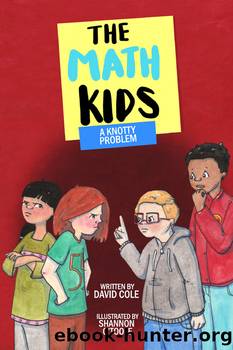A Knotty Problem by David Cole

Author:David Cole
Language: eng
Format: epub
Publisher: Common Deer Press
Published: 2022-09-15T00:00:00+00:00
âThis is what a mathematician would call a trivial knot, or sometimes an unknot.â
âIâd call it a dough-knot,â Jordan said.
âOf course you would,â Justin said. âBut if thatâs an unknot, what would they call a knot?â
âGreat question. This is what is known as a trefoil knot.â He drew another picture on the whiteboard.
âI would call it a pretzel knot,â Jordan said.
Mr. Duchesne smiled and shook his head. âYouâll notice that there is no way to untie this knot. That makes it much more interesting to a mathematician,â Mr. Duchesne explained. âWith a knot like this, we can start to talk about characteristics such as knot crossingsâthis one has three crossings, for exampleâand even things like adding two knots together to make a third knot. Really interesting things.â
âBut none of that helps to solve our problem,â Justin said. âI mean, it doesnât explain why the hose got all knotted up when I tried to water the flowers.â
âNo, it doesnât,â Mr. Duchesne agreed. âAnd the topic of knots and tangles are definitely of interest. I mean, think of the hours people spend untangling hoses and necklaces and Christmas lights. But itâs much more important than that. One example is in molecular biology.â
âBiology?â Justin asked.
âExactly. Youâve heard of DNA, right?â
âDNA is what carries all of the genes, isnât it?â Jordan said.
âExactly,â Mr. Duchesne said. âDNA is a molecule that has two strings that coil around each other. It controls the development, function, and reproduction of all organisms, including things like cancer.â
âWhere do knots fit in?â Justin asked.
âThere are enzymes that change the topology of DNA, causing the strings to form knots. If we can create drugs that inhibit this knot tying, it can cause these cells to die. Drugs like this could be used to treat cancer or as antibiotics to fight infections.â
âMaybe my dad should try an antibiotic on his Christmas lights,â Jordan quipped.
Mr. Duchesne laughed. âI wish it were that easy, Jordan. Unfortunately, no one has really done much math around the issue of Christmas light tangling.â
âIf math canât help, I guess weâre out of luck, huh?â Jordan asked.
âJust because most mathematicians arenât looking at the problem of tangled Christmas lights, it doesnât mean that itâs being completely ignored,â Mr. Duchesne responded. âI read a study from a couple of physicists who did some experiments with putting ropes into boxes that were tumbled at different speeds. They found that complex knots sometimes formed in just seconds.â
âDid they figure out why?â Catherine asked.
âNo, but they did learn some interesting things with their experiment. They learned that the longer the rope was, the more likely it was to get tangled. But they also found that the smaller the box, the less likely the rope would get tangled. So, while itâs not exactly an exact science, it does give us something to work with, right?â
âHow does that help my dad with his Christmas lights?â Jordan asked.
âWell, he can start by making the string of lights shorter,â Mr. Duchesne said.
âHow does he do that?â
âSimple,â Mr. Duchesne said, âtell him to connect the two ends of the lights together.
Download
This site does not store any files on its server. We only index and link to content provided by other sites. Please contact the content providers to delete copyright contents if any and email us, we'll remove relevant links or contents immediately.
The Rise and Fall of Senator Joe McCarthy by James Cross Giblin(5248)
Paper Towns by Green John(5139)
The Giant and How He Humbugged America by Jim Murphy(3413)
The Science Book (Big Ideas Simply Explained) by DK(3253)
Eleanor & Park by Rainbow Rowell(3112)
The President Has Been Shot!": The Assassination of John F. Kennedy by Swanson James L(3070)
The Rape Of Nanking by Iris Chang(2795)
Merriam-Webster's Collegiate Thesaurus, Second Edition by Merriam-Webster Inc(2731)
Harry Potter and the Deathly Hallows (7) by J.K. Rowling(2681)
Ancient Worlds by Michael Scott(2650)
Beautiful Oblivion by Jamie McGuire(2585)
Eligible by Curtis Sittenfeld(2561)
Dork Diaries 12 by Rachel Renée Russell(2348)
Sharp Objects by Gillian Flynn(2253)
The Unlikely Pilgrimage of Harold Fry by Rachel Joyce(2242)
Frankly, Frannie by AJ Stern(2185)
The Astronomy Book by DK(2133)
Forensics by Val McDermid(2071)
Who Was Louis Braille? by Margaret Frith(1956)
